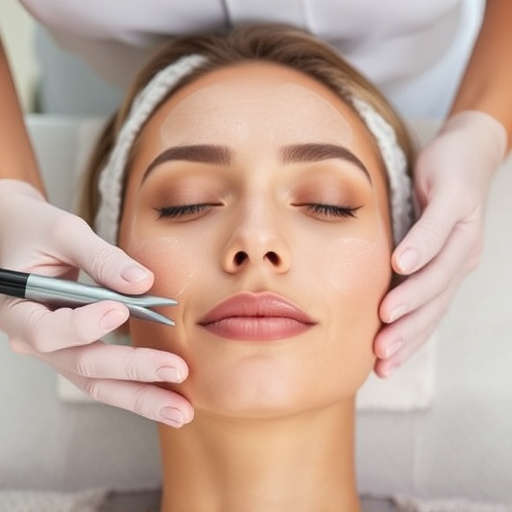Unraveling Ingrown Hair Prevention: Scientific Strategies and Topical Remedies
Ingrown hair prevention involves understanding causes like close shaving, irregular folicle shapes,…….
Ingrown hair prevention is a specialized field focused on addressing a common yet often embarrassing skin concern—ingrown hairs. This phenomenon occurs when hair follicles become trapped beneath the skin’s surface, leading to inflammation, redness, and sometimes infection. While it may seem like a minor issue, ingrown hairs can significantly impact an individual’s self-esteem and overall quality of life. This article aims to provide an in-depth exploration of various aspects related to ingrown hair prevention, offering valuable insights for both individuals seeking solutions and professionals in the skincare industry. By delving into historical practices, scientific advancements, global trends, economic implications, and future prospects, we will uncover the multifaceted world of ingrown hair prevention.
Ingrown hair prevention is a proactive approach to managing and minimizing the occurrence of ingrown hairs. It involves a combination of techniques and strategies aimed at maintaining healthy hair follicles, promoting proper hair growth, and reducing the chances of hairs curling back into the skin. The core components include:
The practice of preventing ingrown hairs dates back centuries, with ancient civilizations employing various natural remedies. For example, the Egyptians used plant-based oils for skincare, while the Greeks and Romans relied on exfoliating salts and herbs to soothe irritated skin. However, modern ingrown hair prevention techniques have evolved significantly through scientific research and technological advancements.
In the 20th century, the development of topical retinoids and their effectiveness in treating acne and unclogging pores opened new avenues for ingrown hair management. Subsequently, laser hair removal technology emerged as a groundbreaking innovation, offering permanent solutions to ingrown hairs and unwanted hair growth. Today, the field continues to advance with ongoing research into advanced skincare ingredients and innovative procedures.
Ingrown hair prevention has become a global phenomenon, with varying degrees of awareness and adoption across different regions. Here’s an overview:
| Region | Impact and Trends |
|---|---|
| North America | Highly influenced by media and beauty standards, the region sees a significant demand for ingrown hair prevention products and services. Laser hair removal is particularly popular, with advanced technologies like IPL (Intense Pulsed Light) gaining traction. |
| Europe | Known for its stringent cosmetic regulations, European countries prioritize safe and effective skincare solutions. The market offers a wide range of topical treatments and specialized clinics providing laser and microdermabrasion services. |
| Asia-Pacific | Rapidly growing economy and changing beauty trends drive the demand for advanced hair removal technologies. Countries like Japan and South Korea are leaders in developing innovative products, including high-tech skincare devices. |
| Middle East & Africa | Increasing disposable income and a focus on personal grooming contribute to the growing popularity of ingrown hair prevention methods, particularly in urban areas. |
| Latin America | Traditional remedies and natural ingredients are widely used alongside modern techniques. The region’s diverse cultural influences shape unique approaches to skin care. |
The global ingrown hair prevention market is a dynamic sector, driven by factors such as changing consumer preferences, medical advancements, and rising healthcare expenditure.
Technological breakthroughs have revolutionized ingrown hair prevention, offering safer, more efficient, and targeted solutions. Some notable advancements include:
The regulation of ingrown hair prevention products and services varies across jurisdictions, ensuring consumer safety while fostering innovation:
Despite its growing popularity, ingrown hair prevention faces several challenges and criticisms:
Scenario: A 30-year-old woman, Sarah, struggles with ingrown hairs on her legs, which cause discomfort and embarrassment. She seeks a long-term solution without the hassle of regular shaving.
Solution: Sarah consults a dermatologist who recommends laser hair removal using an Nd:YAG laser. After a series of treatments, she experiences significant reduction in ingrown hairs and improved skin texture. The procedure is relatively painless, and with proper aftercare, her legs remain smooth for extended periods.
Outcomes: Sarah’s experience demonstrates the effectiveness of advanced laser technologies in providing permanent hair reduction, alleviating her discomfort, and boosting her confidence.
Challenge: A teenager, Alex, deals with both acne and ingrown hairs on his back. He wants a solution that addresses both issues without causing further skin irritation.
Approach: Alex’s dermatologist prescribes a combination of topical treatments, including a retinoid for acne and an AHAs exfoliant to prevent ingrown hairs. The regimen involves gentle cleansing, exfoliation, and moisturizing to maintain healthy skin.
Results: Within a few months, Alex notices improved acne control and reduced ingrown hairs. His skin becomes smoother, and he develops a consistent skincare routine that caters to his specific needs.
Setting: In a multicultural city, a beauty clinic serves clients from diverse backgrounds with varying expectations for ingrown hair prevention.
Strategy: The clinic offers personalized consultations, considering cultural preferences and traditional practices. For example, they adapt shaving techniques for clients who prefer certain hair removal methods due to cultural or religious reasons. Additionally, they provide education on post-hair removal care, catering to diverse skin types and needs.
Impact: By embracing cultural diversity and offering tailored solutions, the clinic fosters a sense of inclusivity and satisfaction among its clientele. This approach leads to positive word-of-mouth recommendations and enhanced loyalty.
The field of ingrown hair prevention is poised for further growth and innovation:
Ingrown hair prevention is a dynamic and essential aspect of skincare, addressing a common yet often overlooked issue. Through an understanding of its historical roots, global impact, economic considerations, technological advancements, regulatory frameworks, and challenges, we can appreciate the complexity and potential of this field. The successful case studies presented highlight the importance of personalized approaches, cultural sensitivity, and evidence-based practices.
As we peer into the future, the prospects for ingrown hair prevention appear promising. With ongoing research, innovative technologies, and a growing awareness of personal grooming, individuals worldwide will have access to effective solutions. This article aims to empower readers with knowledge, dispel myths, and encourage further exploration of this vital aspect of skincare.
Q1: What are the first steps I should take to prevent ingrown hairs?
A1: Start by maintaining a clean and healthy skincare routine. Gently exfoliate your skin regularly to remove dead cells, and choose hair removal methods that minimize trauma to the skin, such as shaving with a fresh razor or trying gentle depilatory creams.
Q2: Is laser hair removal painful?
A2: The level of pain associated with laser hair removal varies from person to person. Modern lasers are designed to be comfortable, and most people tolerate the procedure well. Topical anesthetics can be applied before treatment to reduce any discomfort.
Q3: Can ingrown hairs be completely eliminated?
A3: While complete elimination is challenging, effective prevention strategies can significantly reduce the occurrence of ingrown hairs. Combining appropriate hair removal techniques, skincare hygiene, and topical treatments can lead to long-term improvement.
Q4: Are there any natural remedies for ingrown hairs?
A4: Yes, several natural ingredients have shown promise in preventing ingrown hairs. For example, tea tree oil has antibacterial properties that can help maintain a healthy skin environment, reducing the risk of ingrown hairs. Essential oils like lavender and chamomile also possess anti-inflammatory qualities beneficial for skin soothing.
Q5: How often should I exfoliate to prevent ingrown hairs?
A5: The frequency of exfoliation depends on your skin type and hair growth cycle. Generally, gentle exfoliation 1-2 times per week is recommended. Over-exfoliation can irritate the skin, so it’s essential to find a balanced routine that supports healthy hair growth without causing damage.

Ingrown hair prevention involves understanding causes like close shaving, irregular folicle shapes,…….

Ingrown hairs are a common skin issue caused by friction, sensitive skin, poor hygiene, or condition…….